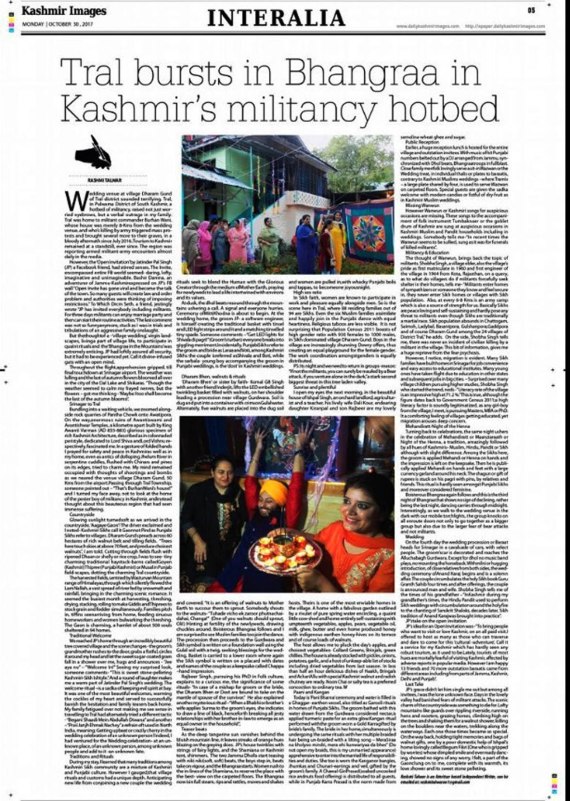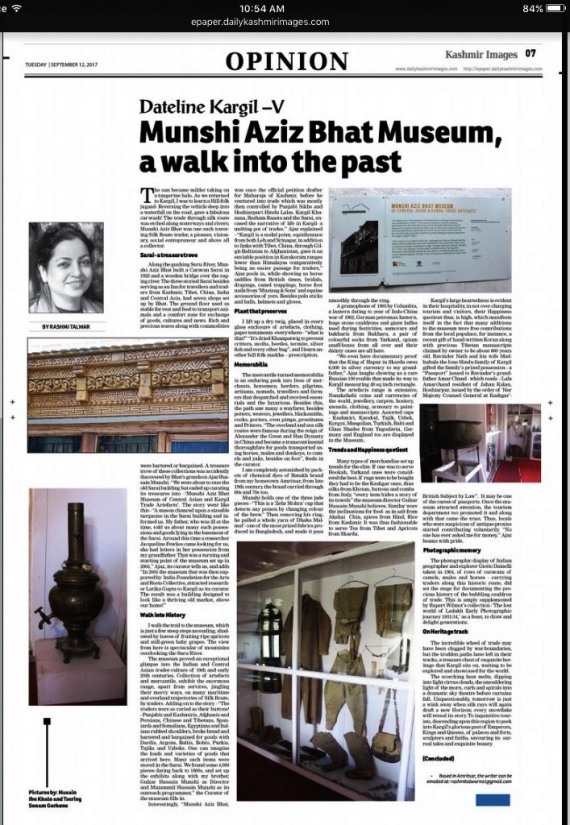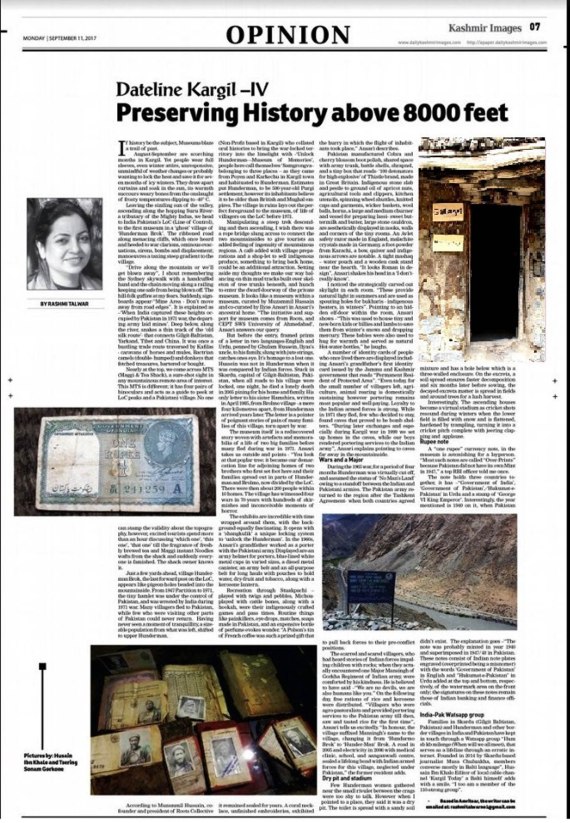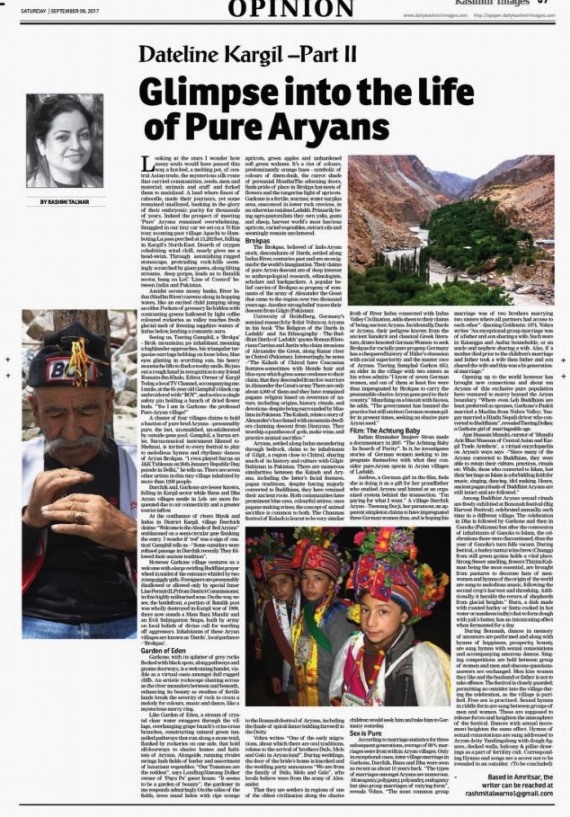
Follow Up
Tral bursts in Bhangraa in Kashmir’s militancy hotbed /
Rashmi Talwar
Wedding venue at village Dharam Gund of Tral district sounded terrifying. Tral, in Pulwama District of South Kashmir, a hotbed of militancy, raised not just worried eyebrows, but a verbal outrage in my family. Tral was home to militant commander Burhan Wani, whose house was merely 8-Kms from the wedding venue, and who’s killing by army triggered mass protests and brought several more to their graves, in a bloody aftermath since July 2016. Tourism to Kashmir remained at a standstill, ever since. The region was reporting armed militant-army encounters almost daily in the media.
However, the ‘Open Invitation’ by Jatinder Pal Singh (JP) a Facebook friend, had stirred senses. The Invite, encompassed entire FB world seemed- daring, lofty, imaginative and unimaginable.
Bashir Damna, an adventurer of Jammu-Kashmir expressed on JP’s FB wall “Open Invite has gone viral and become the talk of the town. So many guests will create law and order problem and authorities were thinking of imposing restrictions.” To Which Drcm Seth, a friend, jestingly wrote “JP has invited everybody including militants. For three days militants can enjoy marriage party and then can start their routine activities.” The last comment was not so funny anymore.
But the thought of a -‘village wedding’, virgin landscapes, living a part of village life, to participate in quaint rituals and the ‘Bhangraa in the Mountains’ was extremely enticing. JP had loftily assured all security, but it had to be experienced yet. Call it divine-infused guts with an open mind.
Throughout the flight, apprehension gripped, till final touchdown at Srinagar airport. The weather was lulling and the last of autumn flowers bloomed all over in the city of the Dal Lake and Shikaras. “Though the weather seemed to calm my frayed nerves, but the flowers – got me thinking – ‘Maybe I too shall become the last of the autumn blooms!’.
Srinagar to Tral
Bundling into a waiting vehicle, we zoomed alongside rock quarries of Pantha Chowk onto Awatipora.
On the way, enormous ruins of Awantiswami and Avantishwar Temples, a kilometre apart built by King Awanti Varman (AD 855-883) glorious specimen of rich Kashmiri Architecture, described as in colonnaded peristyle, dedicated to Lord Shiva and Lord Vishnu respectively, fascinated me. In a gesture of folded hands I prayed for safety and peace in Kashmir as well as in my home, even as antics of dolloping Jhelum River in serpentine cuddles, flushed with Chinars and pines on its edges, tried to charm me.
My mind remained occupied with thoughts of shootings and bombs as we neared the venue village Dharam Gund, 50 Kms from the airport. Passing through Tral Township, someone pointed out – “That’s Burhan Wani’s house!” and I turned my face away, not to look at the home of the poster boy of militancy in Kashmir, and instead thought about this beauteous region that had seen immense suffering.
Countryside
Glowing sunlight turned soft as we arrived in the countryside. ‘Aa gaye Gaon’! The driver exclaimed and I noted- Kashmiri Sikhs call it Gaon not Pind as Punjabi Sikhs refer to villages. Dharam Gund spreads across 60 hectares of rich walnut belt and tilling fields. “Trees here touch skies at above 70 feet, and produce choicest walnuts”, I am told. Cutting through fields flush with ripened Dhaan or shelly or rice crop, I was to see – tiny charming traditional haystack-barns called Goyen (Kashmiri) Thipree (Punjabi Kashmiri) or Musal in Punjab field-scapes, dotting the charming Tral countryside.
The harvested fields, sentried by Wasturvan Mountain range of Himalayas, through which silently flowed the Lam Nallah, a vast spread of river fed by snowmelt and rainfall, bringing in the charming scenic romance. It seemed the busiest month at harvesting, threshing, drying, stacking, rolling to make Giddis and Thiprees to stock grain and fodder simultaneously. Families pitch in, tiffins seen arriving from home, feeding sinuous homeworkers and women bulwarking the threshing. The Gaon is charming, a hamlet of about 500 souls sheltered in 94 homes.
Traditional Welcome
We reached JP’s home through an incredibly beautiful tree covered village and the scene changes – the groom’s grandmother rushes to the door, grabs a fistful, circles it around my head and let the sweet sugar-coated gram fall in a shower over me, hugs and announces – “Jee aya nu” – “Welcome In!” Seeing my surprised look, someone comments- “This is sweet stone-pelleting Kashmiri-Sikh Ishtyle.” And a round of laughter makes me a warm part of Jatinder Pal Singh’s wedding. The welcome ritual – is a sadka of keeping evil spirit at bay. It was one of the most beautiful welcomes, warming the cockles of my heart and served to successfully banish the hesitation and family teasers back home.
My family fatigued over not making me see sense in travelling to Tral had alternately tried a different tactic – “Begani Shaadi Mein Abdullah Diwana” and another –“Praii Janjh Ehmak Nachey” a refrain oft used in North India, meaning: Getting upbeat or crazily cherry in the wedding celebration of an unknown person! Indeed, I had ventured for the Wedding celebration- at an unknown place, of an unknown person, among unknown people and add to it -an unknown fate.
Traditions and Rituals
During my stay, I learned that many traditions among Kashmiri Sikh community are a mixture of Kashmiri and Punjabi culture. However I gauged, that village rituals and customs had a unique depth. Anticipating new life from conjoining a new couple the wedding rituals seek to blend the Human with the Glorious Creator through the medium of Mother Earth, praying for newlyweds to lead a life intertwined with environs and its values.
At dusk, the dhol beats resound through the mountains ushering a call. A signal and everyone hurries. Ceremony of Mitti Khodna is about to begin. At the wedding home, the groom JP- a software engineer, is himself creating the traditional basket with tinsel and LED light strips around it and a matching tinselled tiny spade. Someone comments –“Get LED lights for Shivala di pagri!” (Groom’s turban) everyone breaks into giggling merriment. Incidentally, Punjabi Sikhs refer to the groom and bride as Laraa and Voti, among Kashmiri Sikhs the couple is referred as Shivala and Boti, while the sarbala– young boy accompanying the groom in Punjabi weddings, is the ‘dost’ in Kashmiri weddings.
Dharam Bhen, walnuts & rituals
‘Dharam Bhen’ or sister by faith- Komal GB Singh with another friend Inderjit, lifts the LED embellished twinkling basket filled with walnuts, on her shoulder leading a procession near village Gurdwara. Soil is dug and put into a container with crimson Gulal water. Alternately, five walnuts are placed into the dug soil and covered. “It is an offering of walnuts to Mother Earth to succour them to sprout. Somebody shouts to the walnuts- “Tuhade vicho ek zaroor phutna chaida hai, Changa!” (One of you walnuts should sprout, Ok!) Hinting at fertility of the newlyweds, drawing chuckles around.
Boisterous Bhangraa follows and I am surprised to see Muslim families too join the dance. The procession then proceeds to the Gurdwara and Sikh symbol is written on a foundation wall using the Gulal soil with a twig, seeking blessings for the wedding. Basket is carried to a lower room where again the Sikh symbol is written on a placard with dates and names of the couple as a keepsake called Chappa –hand impression.
Rajbeer Singh, pursuing his PhD in Folk culture, explains to a curious me, the significance of some rituals- “In case of a mishap for groom or the bride, the Dharam Bhen or Dost are bound to take on the mantle of spouse of the survivor.” He also explained another mysterious ritual –“When a Bhabhi or brother’s wife applies Surma to the groom’s eyes, she indicates to draw a line of black, henceforth breaking all jesty relationships with her brother-in-law to emerge as an equal owner in the household”,
Teaser beats
As the deep tangerine sun vanishes behind the bluish mountain line, it leaves streaks of orange hues blazing on the greying skies. JP’s house twinkles with strings of fairy lights, and the Shamiana or Kashmiri tent, shimmers. The two Jammu Dholis start teasing with niki niki (soft, soft) beats, the boys step in, beats take on vigour, and the Bhangraa starts. Women rush to the in-lines of the Shamiana, to reserve the place with the best- view on the carpeted floors. The Bhangraa now is in full steam, rips and rattles, moves and shakes and women are pulled in, with whacky Punjabi bolis and tappas, to become one joyous night.
High sex ratio
In Sikh faith, women are known to participate in work and pleasure equally alongside men. So is the scene here in Tral, where 88 residing families out of 94 are Sikhs. Even the six Muslim families assimilate and happily join in the Punjabi dance with equal heartiness. Religious taboos are less visible. It is not surprising that Population Census 2011 boasts of high gender ratio with 930 females to 1000 males, in Sikh dominated village Dharam Gund. Boys in the village are increasingly shunning Dowry offers, thus creating an equal playground for the female gender. The work coordination amongst genders is equally distributed.
PS: Its night and we need to return in groups- reason: “If not the militants, you can surely be mauled by a Bear attack, if you venture alone in the dark,” a stark second biggest threat in this tree laden valley.
Sunrise and plentiful
I open my eyes the next morning, in the beautiful house of Ishpal Singh, an orchard landlord, agriculturist and a teacher, his lively wife Dali Kour, endearing daughter Kiranpal and son Rajbeer are my lovely hosts. Theirs is one of the most enviable homes in the village. A home with a fabulous garden outlined by a rivulet of pure spring water encircling, a quaint little cow-shed and home entirely self-sustaining with umpteenth vegetables, apples, pears, vegetable oil, milk, ghee, butter and even home produced honey with indigenous earthen honey-hives on its terrace and of course loads of walnuts.
The host allows me to pluck the day’s apples, and choicest vegetables- Collard Greens, Brinjals, green chillies. The house is already stocked with pickles, onions, potatoes, garlic, and a host of unkeep-able list of stocks including dried vegetables from last season. In less than half an hour delicious dishes of Haakh, Bringals and Achari Allu with special Kashmiri walnut and radish chutney are ready. Noon Chai or salty tea is a preferred concoction to ordinary tea.
Paani and Kangan
Today is ‘Pani Bharna’ ceremony and water is filled in a Ghaggar– earthen vessel, also titled as Garooli rituals in homes of Punjabi Sikhs. The groom bathed with this water drawn from the Gurdwara considered nectar, is applied turmeric paste for an extra glow. Kangan ritual performed with the groom worn a Gold Karra gifted by bride’s family.
The bride in her home, simultaneously is undergoing the same rituals with her multiple braided hair being un-braided with a lilting song – Mera Siraa na kholyoo mindri, mera ehi kunwariyaa da bhes” (Do not untie my braids, this is my unmarried appearance) apprehensive to enter into the married life of responsibilities and duties. She too is worn the Kangan or bangles, Jhumkas and Chunari – earrings and veil, gifted by the groom’s family.
A Chawal-Giri Prasad (soaked uncooked rice and nuts food offering) is distributed to all guests, while in Punjab Karra Prasad is the norm made from semolina-wheat ghee and sugar.
Public Reception
Earlier, a huge reception lunch is hosted for the entire village and outstation invitees. With music of hit Punjabi numbers belted out by a DJ arranged from Jammu, synchronized with Dhol beats, Bhangraa troops in full blast. Close family menfolk lovingly serve a sit-in Wazwan or the Wedding treat, in individual thalis or plates to baraatis, contrary to Kashmiri Muslims weddings – where Tramis – a large plate shared by four, is used to serve Wazwan on carpeted floors. Special guests are given the sadka welcome with modern candies or fistful of dry-fruit as in Kashmiri Muslim weddings.
Missing Wanwun
However Wanwun or Kashmiri songs for auspicious occasions are missing. These songs to the accompaniment of folk instrument Tumbaknaer or the goblet drum of Kashmir are sung at auspicious occasions in Kashmiri Muslim and Pandit households including in weddings. Somebody tells me-“In recent times the Wanwun seems to be sullied, sung as it was for funerals of killed militants”.
Militancy & Education
The thought of Wanwun, brings back the topic of militants. Shobha Singh, a village elder, also the village’s pride as first matriculate in 1960 and first engineer of the village in 1964 from Kota, Rajasthan, on a query, as to what do villagers do if militants forcefully seek shelter in their homes, tells me- “Militants enter homes of sympathizers or someone they know and feel secure in, they never enter Sikh homes or villages with Sikh population. Also, at every 6-8 Kms is an army camp which is also a source of strength for us. Basically Sikhs are peace loving and self-sustaining and hardly pose any threat to militants even though Sikhs are traditionally a martial race.
Sikh population abounds in Chattogam, Saimoh, Ladybal, Basantpora, Gulshanpora, Gaddpora and of course Dharam Gund among the 24 villages of District Tral,” he adds. On the side, Shobha Singh tells me, there was never an incident of civilian killing by a militant in the village. This bit of information, gives me a huge reprieve from the fear psychosis.
However, I notice, migration is evident. Many Sikh families have built homes in Srinagar for job convenience and easy access to educational institutes. Many young ones have taken flight due to education in other states and subsequent jobs in big cities. – Surprised over many village children pursuing higher studies, Shobha Singh who started the trend, nods – “Literacy rate of the village is an impressive high at 71.2 %.”
This is true, although the figure dates back to Government Census 2011; a high literacy factor is soundly legitimatized, as any girl-boy from the village, I meet, is pursuing Masters, MBA or PhD. It a comforting feeling of villages getting educated, yet migration arouses deep concern.
Mehandiratt – Night of the Henna
Turning back to celebrations, the same night ushers in the celebration of Mehandiratt or Maanziaraath or Night of the Henna, a tradition, amazingly followed by all hues of Kashmiris- Muslim, Hindu, Pandit or Sikh although with slight difference. Among the Sikhs here, the groom is applied Mehandi or Henna on hands and the impression is left on the keepsake. Then he is publically applied Mehandi on hands and feet with a large currency garland around his neck. The shagun or gift of rupees is stuck on his pagri with pins, by relatives and friends. This ritual is hardly seen amongst Punjabi Sikhs and moreover considered feminine.
Boisterous Bhangraa again follows and this is the third night of Bhangraa that shows no sign of declining, rather being the last night, dancing carries through midnight. Interestingly, as we walk to the wedding venue in the dark with our mobile torchlights, the group knocks on all enroute doors not only to go together as a bigger group but also due to the larger fear of bear attacks and not militants.
Wedding
On the fourth day the wedding procession or Baraat heads for Srinagar in a cavalcade of cars, with select people. The groom’s car is decorated and reaches the Alluchabagh Gurdwara. Except for dhol no music band plays, no mounting the horseback. With milni or hugging introduction, of close relatives from both sides, the wedding ceremony of Anand Karaj begins and is a solemn affair. The couple circumbulates the holy Sikh book Guru Granth Sahib four times and after offerings, the couple is announced man and wife.
Shobha Singh tells me of the times of his grandfather –“In Kashmir during my grandfather’s times, the Hindu Pandit used to perform Sikh weddings with circumbulation around the holy fire to the chanting of Sanskrit Shaloks, decades later, Sikh tradition of Anand Karaj was brought into practice”.
JP’s take on the open invitation
JP’s idea for an Open Invitation was -“To bring people who want to visit or love Kashmir, on an all paid visit. I offered to host as many as those who can traverse and dare to come for this ‘cultural -adventure’.
Call it a service for my Kashmir which has hardly seen any robust tourism, as it used to be. Lately, tourists of most hues are mortally fearful of visiting Kashmir, affected by adverse reports in popular media. However I am happy 13 friends and 70 more outstation baraatis came from different areas including from parts of Jammu, Kashmir, Delhi and Punjab”.
Last Take
JP’s grace didn’t let him single me out but among all invitees, I was the lone unknown face. Days in the lovely valley had banished fears of militant attacks.
The scenic charm of the countryside was something to die for. Lofty mountains like guards over rippling riverside, running hens and roosters, grazing horses, climbing high on the trees and shaking them for a walnut shower, lolling on the boulders near the waters, trekking along the waterways. Each one those times became so special.
On the way back, holding tight memories and bags of walnut gifts, one by a poor domestic help of Ishpal’s home lovingly called Begum Fikri (One who is gripped by worries) whose dimpled smile and ever ready dancing, showed no signs of any worry, I felt, a part of the Gaon clung on to me, complete with its warmth, its love shower and its sweet stone pelleting.
Rashmi Talwar is an Amritsar based Independent Writer, can be emailed at: rashmitalwarno1@gmail.com
00—00


 DATELINE KARGIL PART V
DATELINE KARGIL PART V Dateline Kargil –IV
Dateline Kargil –IV Dateline Kargil III
Dateline Kargil III Dateline Kargil –Part II
Dateline Kargil –Part II










Recent Comments